We use cookies to optimise our website functionality and give you the best experience possible. Please, accept our Terms and Conditions. ACCEPT
ONAM IS THE MOST POPULAR FESTIVAL IN KERALA. IT CAN BE TRACED TO THE PRIMITIVE HARVEST FESTIVAL AND ALSO TO THE MYTH REGARDING KING MAHABALI - THE BENEVOLENT ASURA RULER WHO BROUGHT PEACE AND PROSPERITY TO HIS COUNTRY.
According to Hindu Mythology, the Brahmin sage Prahlada had a grandson named Mahabali who took over the three worlds by defeating the Gods (Devas). In Vaishnavism, the Devas approached Lord Vishnu to help them in the battle against Mahabali, Vishnu refused considering Mahabali being a good ruler and his devotee. Mahabali performed a Yajna after his victory over the Gods and had to grant anyone any request. Lord Vishnu took this opportunity to test Mahabali's devotion and approached Mahabali in the avatar of a dwarf boy called Vamana.
The king offered everything he could to the boy, but Vamana refused and said one must not seek more than one's needs and all he needed was three-paces. Mahabali, although surprised by the boy's wish, agreed to grant it. Vamana grew and covered the land and water with one foot and the sky with another foot, now to place his third-foot Mahabali offered himself. Vamana trampled Mahabali down to Pathala (hell) but pleased by his devotion offered him a boon to visit his land every year. The revisit of Mahabali marks the festival of Onam.
ATHAM (1 September 2019) - On the day of Atham, festivities begin at the Vamanamoorthy Thirrikara Temple in Kochi, where a grand procession is held called as Athachamayam. The day marks the preparations of the visit of Mahabali to his Kingdom. This is followed by the laying of Pookalam which is made of only yellow petals. The Pookalam on Atham is known as Athapoo which is made of only one layer that gets added on progressively as each day of Onam passes. Statues of Mahabali and Vamana are placed on the courtyards that are dung-plastered in front of the house.
CHITHIRA (2 September 2019) - On the second day of Onam, two more layers of orange and creamy yellow flowers are added to the Pookalam. People clean their houses and visit temples on this day.
CHODHI (3 September, 2019) - The third day of Onam is when people buy new clothes otherwise called as Onakkodi. Women dress up in Kasavi Saree, and men purchase mundu while young girls wear Pattu Pavada. Families go shopping as well as gift each other jewels and clothes. The third layer of flowers is added to the Pookalam as well.
The Onam celebrations across the state, starts off with a grand procession at Thrippunithura near Kochi called Atthachamayam, also referred to as Thripunithura Athachamayam. The parade features elephants marching, drum beats and other music, folk art forms, floats and colorfully dressed people with masks. In Kerala's history, the Kochi king used to head a grand military procession in full ceremonial robes from his palace to the Thrikkakara temple, meeting and greeting his people. In contemporary times, this is a state supported event.
The parade floats traditionally feature scenes from epics such as the Mahabharata and the Ramayana. Additionally, some floats include themes from the Bible as well as current themes thereby highlighting unity and harmony.
The procession path historically has been from Tripunithura to the Vamanamoorthy Temple in Thrikkakara, Ernakulam district. The temple is dedicated to Vishnu in his Vamana (dwarf) avatar. After arrival at the temple, the marchers offer a prayer.
The floral carpet, known as Onapookkalam or just Pookkalam, is made out of the gathered blossoms with several varieties of flowers of differing tints pinched up into little pieces to design and decorate patterns on floor, particularly at entrances and temple premises like a flower mat. Lamps are arranged in the middle or edges. It is a work of religious art, typically the team initiative of girls and women, who accomplish it with a delicate touch and a personal artistic sense of tone and blending. When completed, a miniature pandal (umbrella) hung with little festoons is erected over it.The pookkalam is similar to Rangoli which is made of powders of various colors and is popular in North India.
The traditional ritual of laying pookkalam starts on Atham day. The pookkalam on this day is called Athapoo, and it is relatively small in size. The size of the pookkalam grows in size progressively with each day of the Onam festival. Only yellow flowers will be used on Atham with only one circular layer made and the design is kept simple. Statues or figurines of Mahabali and Vamana are also installed at the entrance of each house on this day.
Traditionally, Atthapookalams included flowers endemic to Kerala and the Dashapushpam (10-flowers), but nowadays all varieties of flowers are used. Earthen mounds, which look somewhat like square pyramids, representing Mahabali and Vamana are placed in the dung-plastered courtyards in front of the house along with the Pookalam, and beautifully decorated with flowers. All over Kerala, Pookalam competitions are a common sight on Onam day.
VISHAKAM (4 September 2019) - This day is considered as the most auspicious as the Onasadya preparations commence. The woman in the family stock up ingredients from the market. Usually, markets hold their harvest sale during this period making Kerala markets the busiest place. The dishes go up to 26 - 30 in different families. After all, Onasadya is all about filling the plantain leaf with dishes until there's no space left.
ANIZHAM (5 September 2019) - The Vallamkali or Snake boat races flag-off on the Pamba River and the Pookalam grow bigger.
THRIKETA (6 September, 2019) - Fresh flowers are added to the Pookalam. Families visit their ancestral homes and spend some time exchanging gifts.
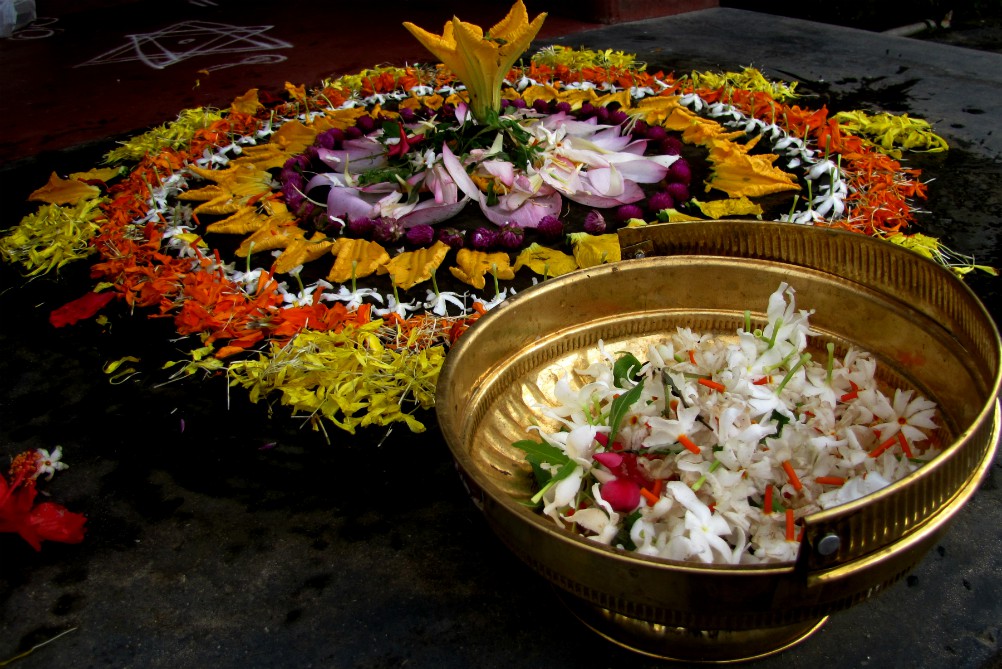 ©
UNKNOWN
©
UNKNOWN
The importance of the feast to the Kerala's Onam celebration culture is captured in the famous Malayalam proverb "Kaanam Vittum Onam Unnanam" which means "One must have the Onam lunch even by selling one's property, if need be".
The sadhya is usually served for lunch, although a lighter version is served for dinner too. Preparations begin the night before, and the dishes are prepared before ten o' clock in the morning on the day of the celebration. A typical Sadhya can have about 24–28 dishes served as a single course. In cases where it is a much larger one it can have over 64 or more items. It has to be prepared by approved chefs to be eligible as a valla sadhya, where physical and spiritual purity is important. During a traditional Sadhya celebration people are seated cross-legged on mats. Food is eaten with the right hand, without cutlery. The fingers are cupped to form a ladle.
The dishes are served on specific places on the banana leaf in specific order. For example, the pickles are served on the top left corner and the banana on the bottom left corner, which helps the waiters to easily identify and decide on offering additional servings. The most common ingredients in all the dishes are rice, vegetables, coconut and coconut oil as they are abundant in Kerala. Coconut milk is used in some dishes and coconut oil is used for frying and also as an ingredient in others.
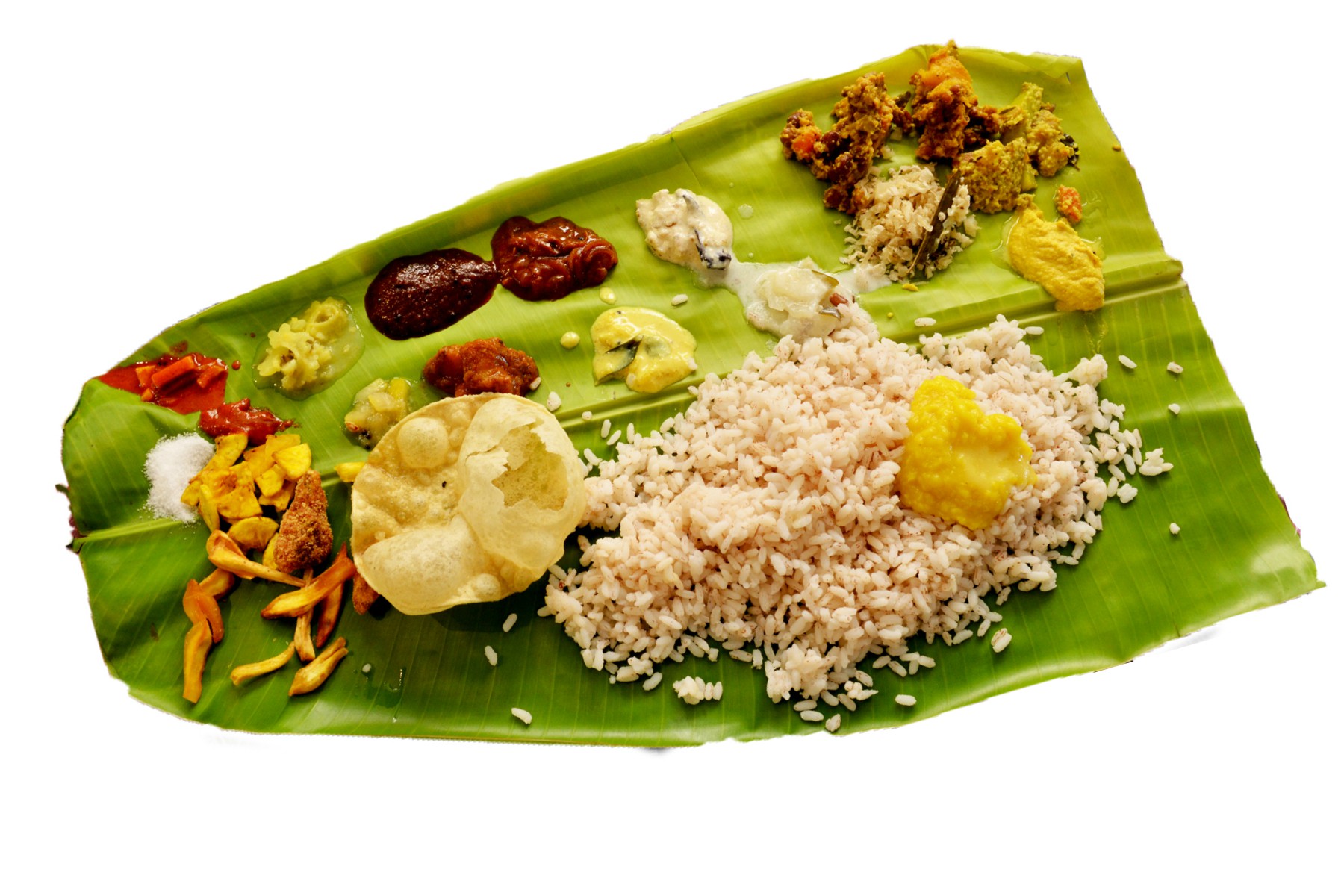 ©
UNKNOWN
©
UNKNOWN
There are variations in the menu depending on the place and religion. Some communities, especially those in the northern part of Kerala, include non-vegetarian dishes in the sadhya. Although custom was to use traditional and seasonal vegetables indigenous to Kerala or South West Coast of India, it has become common practice to include vegetables such as carrots, pineapples, beans in the dishes. Tradition has it that Onion and garlic are not typically used in the sadhya. Conventionally, the meal may be followed by vettila murukkan, chewing of betel leaf with lime and arecanut. This helps digestion of the meal and also cleanses the palate.
Would you like to taste it? Read article about Onam Sadhya >>
Traditional dance forms including Thiruvathira, Kummattikali, Pulikali, Thumbi Thullal, Onam Kali and others. Thiruvathira Kali is a women's dance performed in a circle around a lamp. Kummattikali is a colourful-mask dance. In Thrissur, festivities include a procession consisting of caparisoned elephants surrounded by Kummatikali dancers. The masked dancers go from house to house performing the colorful Kummattikali. Onam Kali is a form of dance where players arrange themselves in circles around a pole or tree or lamp, then dance and sing songs derived from the Ramayana and other epics.
Kathakali dance is also commonly performed during this time, with dancers enacting famous mythological legends. A famous venue for this is at Valluvanad which is associated with the growth of Kathakali, and Cheruthuruthy, where Kerala Kalamandalam is located.
MOOLAM (7 September 2019) - Most temples start offering Onasadya on this day. Families prepare a shorter version of the Sadya. The Pulikali and Kaikottukali are performed at various places in Kerala. The state starts getting colourful and busy with celebrations.
POORADAM (8 September 2019) - The day begins with the ritual of installing clay statues of Mahabali and Vamana commonly called Onathappam in the centre of Pookalam. They are the representation of Mahabali, and fixing these statues symbolises an invitation to Mahabali to visit each house. By now the Pookalam is much bigger and complex.
UTHRADAM (9 September 2019) - This is considered as the Onam even when the preparations reach its zenith. The devotees fully prepare themselves to welcome King Mahabali the next day.
On the fourth day of Onam celebrations, performers painted like tigers and hunters in bright yellow, red, and black dance to the beats of instruments like Udukku and Thakil. Literal meaning of Pulikkali is the 'play of the tigers' hence the performance revolve around the theme of tiger hunting. The folk art is mainly practiced in Thrissur district of Kerala.
The origin of Pulikkali dates back to over 200 years, when the Maharaja Rama Varma Sakthan Thampuran, the then Maharaja of Cochin, is said to have introduced the folk art, who wanted to celebrate Onam with a dance that reflected the wild and macho spirit of the force. Later, Konar of (Pattalam Road) used to celebrate with great fervor. They popularised the folk genre with steps and body language peculiar to a tiger being stalked by a hunter, enacting a play of the hunter and the beast. Along with the celebrations, they used to perform the art form decked as tigers with peculiar steps resembling the tiger, then known as 'Pulikkettikali' which was immensely enjoyed by the locals. Pulikkali in Thrissur is held in memory of this event.
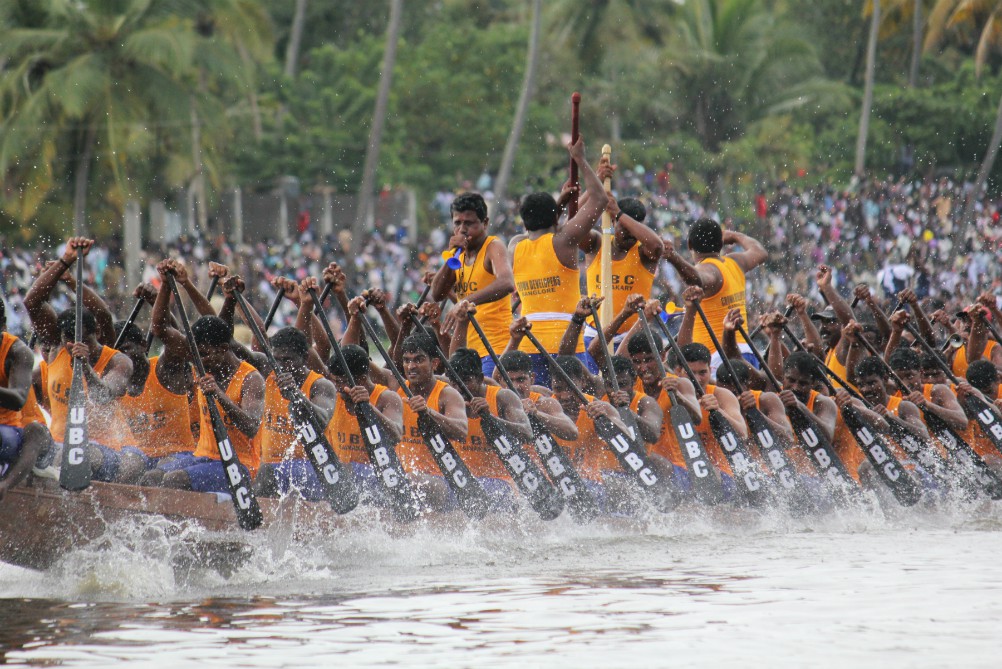 ©
KERALA TOURISM
©
KERALA TOURISM
The Vallamkali, ell-known races include the Aranmula Uthrattadhi Boat Race and the Nehru Trophy Boat Race. Numerous oarsmen row huge snake-shaped boats. Men and women come from far and near to watch and cheer the snake boat race through the water. This event is particularly featured on the Pampa River, considered sacred and Kerala equivalent of Ganges River.
In Kerala, during an early 13th-century war between the feudal kingdoms of Kayamkulam and Chembakassery, King Devanarayana of Chembakassery commissioned the construction of a war boat named Chundan Vallam and he tasked a famous carpenter of the day with the responsibility of creating it. Hence, the technical methods for creating these snake boats are around 650 years old. Of the snake boats still in use today, the Parthasarathi Chundan is the oldest model.
UTHRADAM - FIRST ONAM (10 September, 2019) - This day is the eve of Onam and considered as the First Onam. It is the most auspicious day to purchase fresh fruits and vegetables. According to traditional beliefs, Mahabali arrives in Kerala on this day. Hence, people clean their houses and do their final Onam shopping.
THIRUVONAM ONAM 2019 (11 September 2019) - The main day of Onam festival when people apply rice flour batter on the entrance of their houses as a traditional welcome sign, take a shower and dress up in new clothes and also distribute alms to the poor and needy. This is the day King Mahabali visits each home and blesses every family in Kerala. The Pookalam is completed perfectly, and the families gather to feast on the Onasadya.
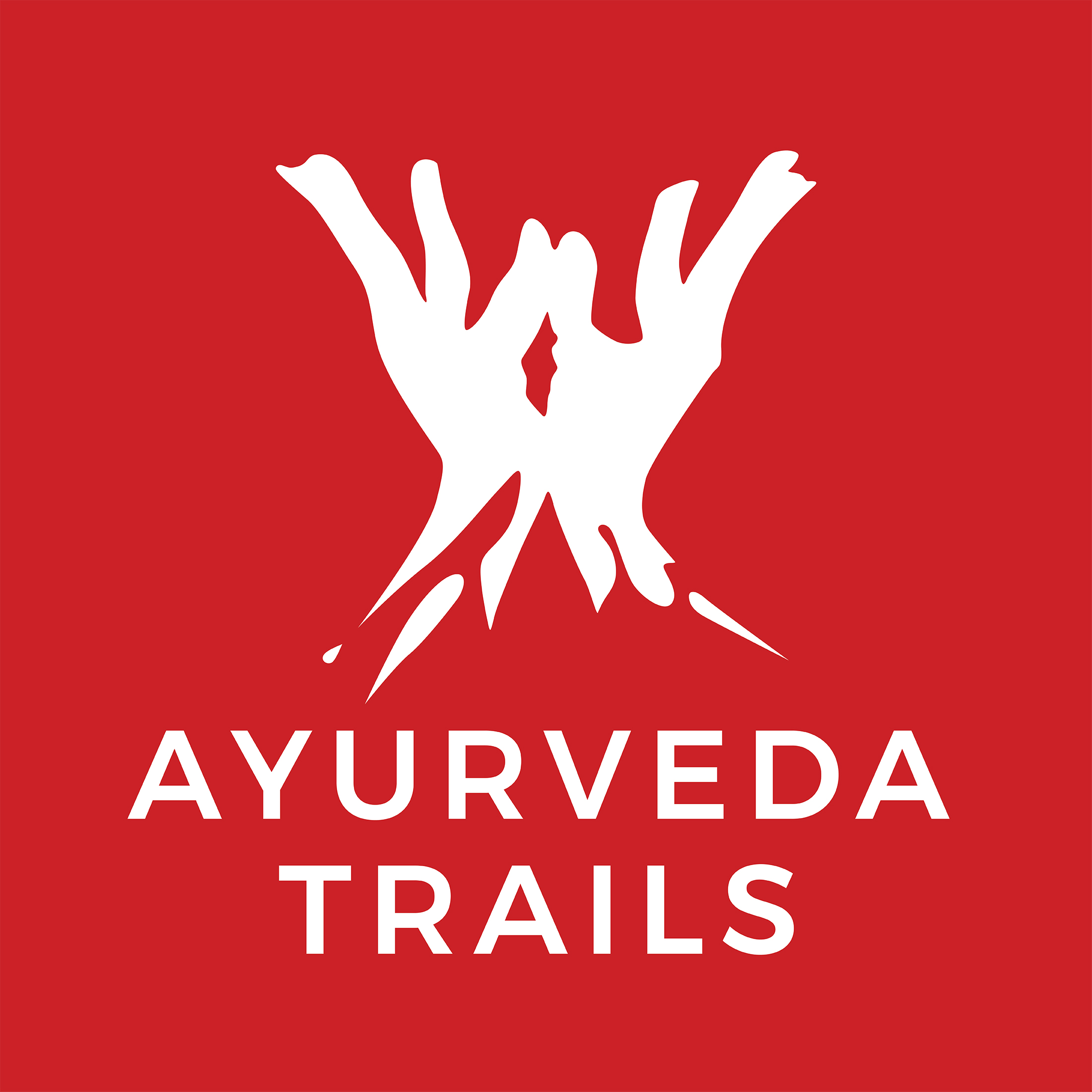
Dedicated to everyone, who is searching answers to these questions: What is ayurveda? How is this ancient medical system connected with yoga, meditation, healthy food, relaxation in nature and modern life style?
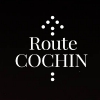
The online magazine delves deep into the history and culture of Kochi, through stories unearthing its eventful past, exploring the interesting juncture the city is at today and envisaging the days to come.